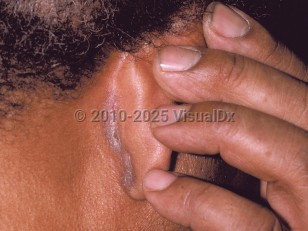Seborrheic dermatitis - Anogenital in
See also in: Overview,Hair and ScalpAlerts and Notices
Important News & Links
Synopsis

Infantile seborrheic dermatitis usually manifests in the second week of life and lasts 4-6 months. In infants, it characteristically presents on the face, diaper area, and folds of the neck and axillae. It usually is not associated with pruritus.
Seborrheic dermatitis has a bimodal distribution, with peaks in infancy and adolescence / early adulthood. Maternal history of seborrheic dermatitis has been found to be a significant risk factor for development of seborrheic dermatitis in infancy and childhood. Although seborrheic dermatitis has been associated with HIV infection and neurologic disease, it typically presents in healthy individuals.
The yeast Malassezia has long been regarded as the central predisposing factor to disease development. Malassezia is a normal component of skin flora, but in individuals with seborrheic dermatitis, the yeast invades the stratum corneum, resulting in free fatty acid formation and the activation of the inflammatory cascade. Changes in the skin microbiome, such as increased Staphylococcus aureus colonization, have also been implicated in pathogenesis. Additional factors related to the environment, such as low temperatures and humidity, have been identified as potential triggers.
Codes
L21.9 – Seborrheic dermatitis, unspecified
SNOMEDCT:
50563003 – Seborrheic dermatitis
Look For
Subscription Required
Diagnostic Pearls
Subscription Required
Differential Diagnosis & Pitfalls

Subscription Required
Best Tests
Subscription Required
Management Pearls
Subscription Required
Therapy
Subscription Required
Drug Reaction Data
Subscription Required
References
Subscription Required
Last Updated:01/14/2025
 Patient Information for Seborrheic dermatitis - Anogenital in
Patient Information for Seborrheic dermatitis - Anogenital in - Improve treatment compliance
- Reduce after-hours questions
- Increase patient engagement and satisfaction
- Written in clear, easy-to-understand language. No confusing jargon.
- Available in English and Spanish
- Print out or email directly to your patient


